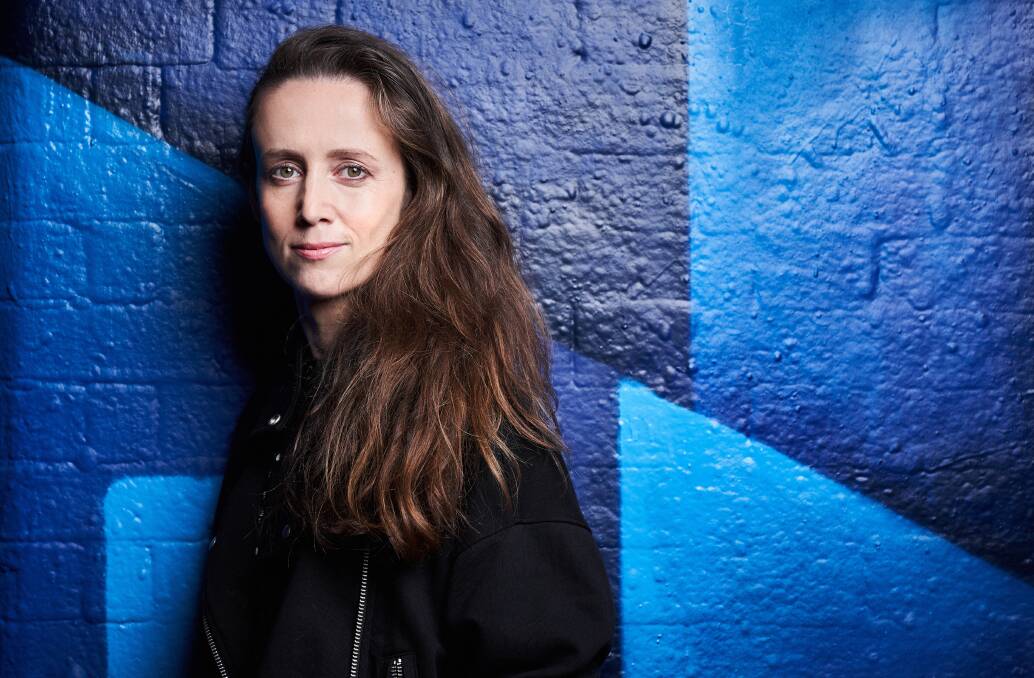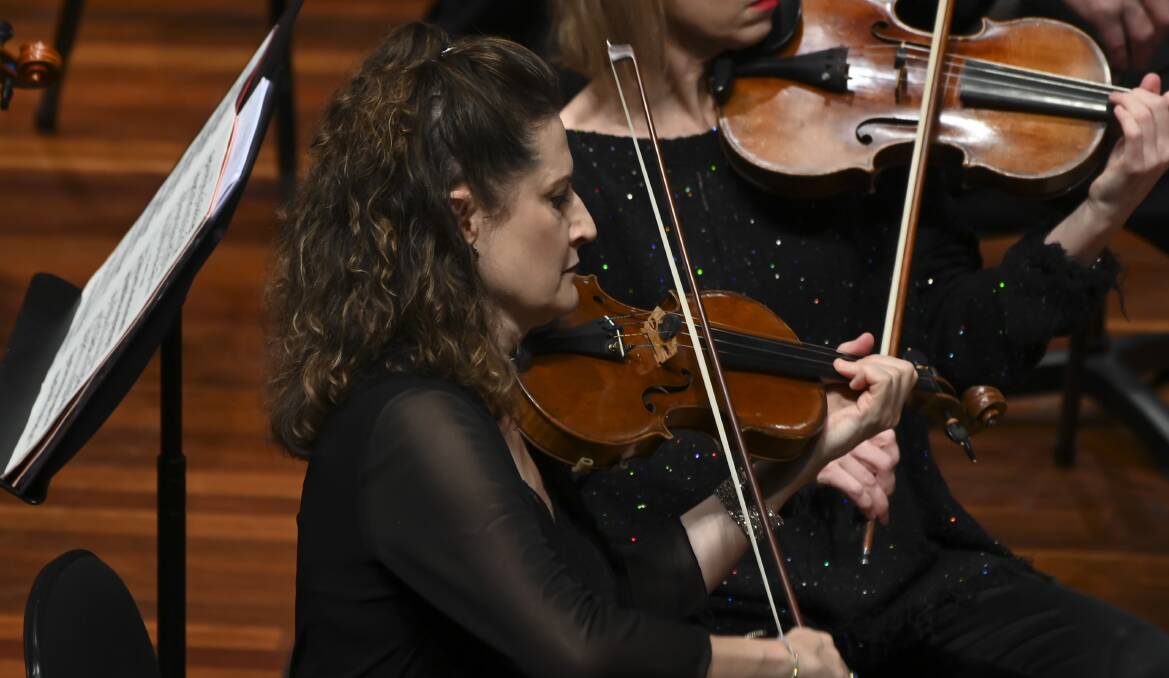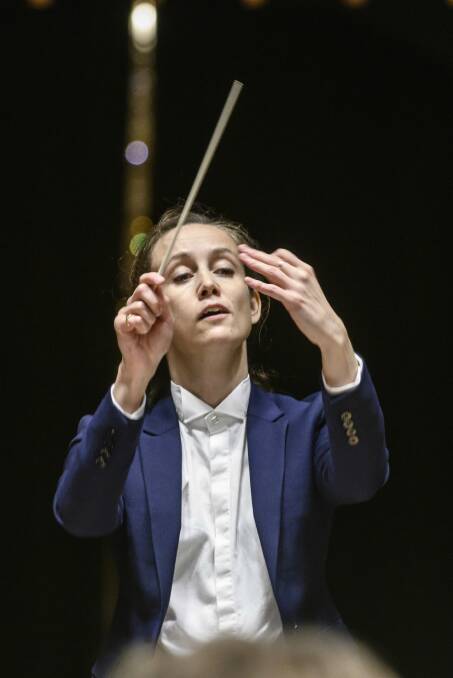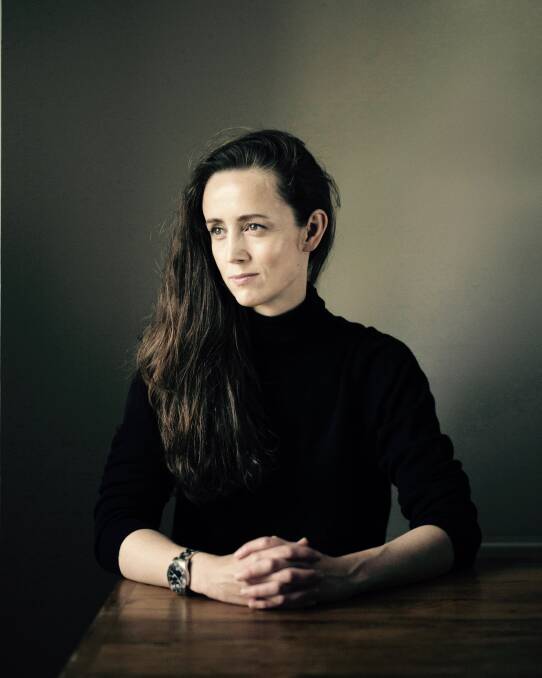Striking the right chord for a year of visionaries
It began with a chord – a single, deceptively simple-looking chord, made up of F, B, D sharp, and G sharp.
Known as the Tristan Chord, it’s the opening phrase of Richard Wagner’s opera Tristan and Isolde, and Jessica Cottis just couldn’t get it out of her head.
It was mid-pandemic, and the chief conductor and artistic director of the Canberra Symphony Orchestra was at home in London, in and out of lockdown, and thinking about the future. And from there, she began to conceptualise the orchestra’s 2022 season program.
“I often just start with one seed, one kernel of an idea,” she says.
“And for this 2022 season, it was actually literally just one chord that was playing in my head over and over.”
Thinking back, she says, it may have been a reflection, subconscious or otherwise, of the state of the world, and her need to look forward.
“It was playing in my mind, and perhaps that had something to do with the pandemic in the sense that, certainly in the UK, we’d been in lockdown after lockdown,” she says.
“I mean, for musicians in the UK, it was 12 months of no work, it was so incredibly demoralising, this sense of almost suspending hope and trusting that, you know, it would ultimately be okay, but through some fairly difficult times.”
But that chord seemed to contain a message.
“The way that Wagner uses harmony is not dissimilar – he kind of spins ideas, harmonic ideas over a very long period of time and it’s not until you’ve got through X number of minutes of music that you actually finally come to some resolution,” she says.

Canberra Symphony Orchestra chief executive Rachel Thomas. Picture: Martin Ollman
“[The chord] is one of the most blazingly original harmonic ideas in the history of Western classical music, and from that point onwards I thought, what we need now, is we need vision. Where are we going, what are we doing with classical music, how are we engaging with our audiences? How are we shaping the history of Australian music? And all of these things came together to create a 2022 season which is based on the idea of visionaries.”
Cottis is indeed a visionary, and it’s not just because she’s speaking to me over Zoom from northern Sweden – the post-lockdown world, the future.
And, just as she sees links between the dense forest canopies of Sweden and the dry, temperate forests of southeast Australia, where she is from, when it comes to music, she has a practice of discerning themes and tendrils, linking pieces of music of various styles, eras and traditions and creating a new atmosphere.
She’s also a synesthete, seeing colours in suites of music that help her to visualise them better – a flourish that plays an important part in how she arranges works and presents programs.
“I think when you come for an evening where some people want to be nourished by the music, some people want to be nourished and also have a sort of intellectual element,” she says..

Jessica Cottis in action. Picture: Martin Ollman
“Some people are looking for a narrative, a kind of theatrical quality of it. For me, I get great intellectual pleasure, actually, finding spurious links, tenuous links between pieces, and it’s really possible to be incredibly creative and imaginative, and I think you’ll see that in the 2022 season.”
The season, which opens in April with the Wagner that began it all, also takes in Bach, Handel and Beethoven, Schubert, Sibelius, Debussy and Stravinsky, as well as 20 separate Australian works by the likes of Richard Meale, Margaret Sutherland, Deborah Cheetham, Malcolm Williamson and Leah Curtis. There are also new commissions by Christopher Sainsbury, Rhyan Clapham and Jakub Jankowski.
The separate concerts have evocative themes – Redemption, Miracles in the Age of Reason, War and Peace, Messiah, Infinite Possibilties, Stargazers and Collective Memory. And all are linked by notes, themes, stories and sounds that, at first, only Cottis can see.
“Our first concert, Redemption, is the Wagner that I was talking about, and then we jump to Bernard Herrmann, who wrote film music, and was deeply influenced by Wagner, especially for Vertigo, the Hitchcock film,” she says.
“And then, an incredibly innovative Australian composer, Margaret Sutherland, her violin concerto, and then actually jumping right back to the early romantic period, and playing Mendelssohn’s Fifth Symphony, which then later influenced Wagner.
“So there are all these tendrils, these webs of connectivity between all these composers, even though they’re from completely different places and completely different times…it’s multi-layered, there’s a lot to take on, as much or as little as people like.”

Jessica Cottis sees music in colour. Picture: Martin Ollman
Although based in London, she’s looking forward to coming back to Canberra, the place where, in many ways, her musical career began, at the Australian National University School of Music and at the organ of St Andrew’s Cathedral in Forrest. She embarked on a promising career as an organist in Europe, but this was cut short by Carpal Tunnel Syndrome in 2005.
A shift to conducting the following year – a direction she hadn’t considered before – has seen her career swell to dozens of guest appearances, both here and in Europe.
But Canberra, for Cottis, is somewhere special.
“For me, there’s a very special connection with everyone in the CSO actually, from the management, right at the top, through everyone who worked behind the scenes and of course with the wonderful musicians of the orchestra,” she says.
“Obviously we’re in touch, regularly, digitally, but I’m missing those day-to-day connections, and also those moments in Llewellyn Hall and in our other venues, of connecting with Canberra audiences. And having a chat to people after we finish concerts – there are so many people in Canberra who are just fascinating.”

Kirsten Williams in action. Picture: Martin Ollman
She’s also, it must be said, especially pleased to be leading an organisation of which the conductor, chief executive and concertmaster are all women – a phenomenon perhaps not as remarkable these days as it was when Cottis was coming of age.
“We’re all looking in the same direction – we all want the same things in the orchestra,” she says.
“So that makes it really inspiring, and there’s just infinite possibility, working in an environment like that, I think.”
Meanwhile, in Sydney, concertmaster Kirsten Williams, is busy packing up her life in preparation for a permanent move to Canberra.
She joined the Sydney Symphony Orchestra more than 20 years ago, but since being appointed to the Canberra orchestra two years ago, she’s done her fair share of travel up and down the highway.
“But my heart and soul is in Canberra now,” she says. “It’s the next logical step for me, for a variety of reasons.”
From a non-musical family, Williams first picked up a violin at the age of four – a vision that might strike fear in the hearts of countless parents who’ve endured the nails-on-blackboard dragging of childish bow on reluctant strings.
But Williams, by all accounts, took to the instrument from the first moment – and, perhaps not coincidentally, now has a particular interest in giving young people pathways into music.
She began studying at the Sydney Conservatorium while still in primary school, and joined the Australian Chamber Orchestra at just 21, and played for a time at Covent Garden in London. After returning home to Sydney, she was appointed co-concertmaster for the Sydney Symphony while a single mother to a tiny daughter.
Today, that daughter is 25 and a musician as well, and Williams has a longtime commitment to community-based music programs, and using the power of music to heal and connect. It’s a perspective Canberra is more than willing to embrace, with a new program for budding musicians aged 14-19.
“I’ve always said there’s a sort of a freshness to the Canberra Symphony family – everything works so well together,” she says.
“I am passionate about music for healing and reaching into the community in smaller groups to reach those people that can’t get to the stage for whatever reason, and Canberra is very open to receiving this kind of energy that I have.
“I think we’re just extraordinarily lucky that everybody’s there for the same reason. And I think it’s probably a little bit unusual in arts organisations.”
And it helps that her senior colleagues – including the curator of the orchestra’s 2021 Australian Series Deborah Cheetham – are also women.
“It’s very creatively satisfying for me…I’m very passionate about women in music, of course I am, and there was a time when there were very few concertmasters who were women…I’m not tough as boots. I guess I’m strong, but it took me a long time to find my feet as a concertmaster.”
But she’s particularly excited to be moving into the post-COVID era, when so many things feel possible.
“As I reflect on it all, it strikes me that COVID has been like the societal expression of what we experience in our lifetimes, as human beings,” she says.
“We experience grief and loss – in this case of course it’s as people, but for us as musicians, it’s our income, our creativity and our identity. And then we need to work through that and work out how we support ourselves with our mental health and each other. We need that connection more than ever, which I’m passionate about.”

Not to mention the fact that the CSO’s 100-odd casual musicians are distinctly talented – up there with any of the countless artists she’s performed with in Sydney and elsewhere.
But, as chief executive Rachel Thomas is quick to point out, Canberra’s orchestra is unique in that the players are consummate professionals who perform only part-time. Most have parallel careers, either in the arts or in other sectors altogether.
Speaking from her office in Civic, she says she views her role as maintaining “that very clear vision for where your organisation is, but also to ensure that all of the people who are involved in our programming are just as aware of that.”
It’s all the more important when the musicians have separate lives and careers, and it’s made easier – or at least more exciting – by working with other senior women.

“I do think there’s a natural energy between Kirsten, Jessica and myself – and Deborah, when she’s in the meetings as well – that is driven by our vision and what we know the orchestra can be in coming years,” she says.
And so we’re really working towards a common goal. And there’s no room for ego…Our meetings are very heartfelt, and come from a place of just wanting to do really good work.”
- View details of the Canberra Symphony Orchestra’s 2022 season at cso.org.au.
Our journalists work hard to provide local, up-to-date news to the community. This is how you can continue to access our trusted content:
Views: 3